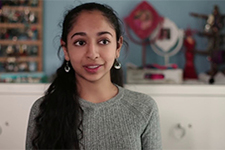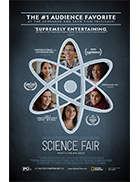Science Fair
|  Science Fair, an engaging, entertaining, and enormously insightful documentary by Cristina Costantini and Darren Foster, follows the trajectories of a dozen students from around the world as they compete to win a spot at the prestigious Intel International Science and Engineering Fair (ISEF), which hosts 1,700 finalists from about 80 different countries each year and offers a top prize of $75,000. The film begins in 2012 with then-15-year-old Jack Andraka winning that top prize, an event that sends him into a cataclysm of leaping, wide-eyed, open-mouth hysterics. The goal, I imagine, was to show just how high emotions can run in the world of top-tier science fair competition and what it means to win this coveted international prize, although the actual effect is a little trickier, as it gives the impression of treating the film’s subjects like socially awkward nerd-objects to be laughed at (footage of Andraka’s gaping-mouth delight is framed with a more recent interview with him, where he happily concedes how goofy his behavior was). The film quickly rights itself, though, as we are introduced to the teenage scientists who will be followed over the course of a year, each of whom emerges as a distinct, likeable personality that often stands in stark contrast to the others. You have, on the one hand, Anjali Chadha, a certified Type-A extrovert with an invention for detecting arsenic in water sources whose competitiveness is matched only by her forthrightness in assessing her place in the world (“I would say that a lot of people are jealous of me,” she says at one point without even a hint of self-consciousness). On the other hand, you have Robbie Barrat, a long-haired West Virginia computer programmer with bad math grades, a penchant for loud shirts, and a love of feeding his artificial intelligence program Kanye West lyrics so it can write its own. In one case, the personality differences are within a collaborating group, which we see in Ryan Folz, Harsha Paladugu and Abraham Riedel-Mishaana, a trio of polar opposite seniors who are collaborating on an electronic, 3-D-printed stethoscope for detecting heart abnormalities. And then we have Kashfia Rahman, a soft-spoken Muslim girl whose science success goes completely unnoticed and uncelebrated in her mostly white and athletics-obsessed North Dakota high school (although, ironically, the only teacher she can get to sponsor her work is a well-meaning football coach). We also meet competitors from other countries, including Ivo Zell, a German teen who wants to redesign the flying wing, and Myllena Braz de Silva and Gabriel de Moura Martins, two Brazilian teens who are working on a cure for the Zika virus, which ravaged their small, poor community. For the most part the focus of the film is on the teens themselves, although we also get interviews with many of their parents and some of their teachers, and there is significant focus on Serena McCalla, a brash, extremely dedicated Long Island science teacher who expends virtually all of her time and energy on her students. The general trajectory of the film is blessedly straightforward, as we follow along with all of these competitors as they first introduce their projects at qualifying national science fairs to win the right to compete at ISEF. At all times Costantini, a journalist-turned-filmmaker, and Foster remind us that their subjects are kids—teenagers with particularly heightened hopes and dreams and ambitions about changing the world, but also with awareness of all the baggage that goes along with being an adolescent. They are all dealing with different issues: Myllena and Gabriel struggle against the realities of limited resources in their poor Brazilian community, something that Anjali, who attends the prestigious and well-funded duPont Manual magnet high school in Louisville, KY, doesn’t. The kids have to balance their STEM dreams with their social lives, which include attending senior prom, an issue that Kashfia, who is all but invisible when she isn’t winning science awards, seems to bypass altogether. Each kid is memorable and engaging in his or her own right, and the film’s wonderful sense of egalitarianism extends to our viewing experience, which makes it all but impossible to root for one of them over the other. They’re all quirky and funny and enjoyable and flawed in their own way, and we find ourselves wishing they could all take home the top prize and join Jack Andraka in joyous, open-mouthed hysterics. Alas, that is not the case, as only one in 1,700 will take home that top prize, and there is no guarantee that it will be any of the film’s subjects. And the fact that it doesn’t really matter is what gives Science Fair its real weight. Although it is deeply enjoyable and entertaining, it also reminds us of the importance of nurturing scientific minds and encouraging the young to not only be curious about their world, but passionate about making it a better place. Copyright © 2018 James Kendrick Thoughts? E-mail James Kendrick All images copyright © National Geographic Documentry Films |
Overall Rating: 


 (3.5)
(3.5)


